High inside your nose are odor receptors that help you decipher and enjoy the world around you. Scents enhance your experiences and can quickly transport you to a past event when the same scent was present. It’s almost instinctual to lean forward and inhale slowly when you’re close to or holding fragrant flowers.
They might take you on a ride down memory lane or help you create a new memory altogether. Some flowers are used in aromatherapy practices to improve emotional well-being by delivering a unique olfactory experience. The best-smelling flowers don’t just provide you with a feast for the eyes, but they also release tiny molecules to enhance your experience as you appreciate them.
Just as there are pleasant-smelling flowers found throughout the world, there are some that emanate powerful, stomach-turning odors. These aren’t the types of flowers you lean into. They’re more the type to run away from just before you lose your lunch. In the list below, we highlight ten of the best-smelling flowers you can enjoy and five of the worst-smelling flowers that you can avoid (unless you’re into that kind of thing!).
The Best-Smelling Flowers
1. Jasmine
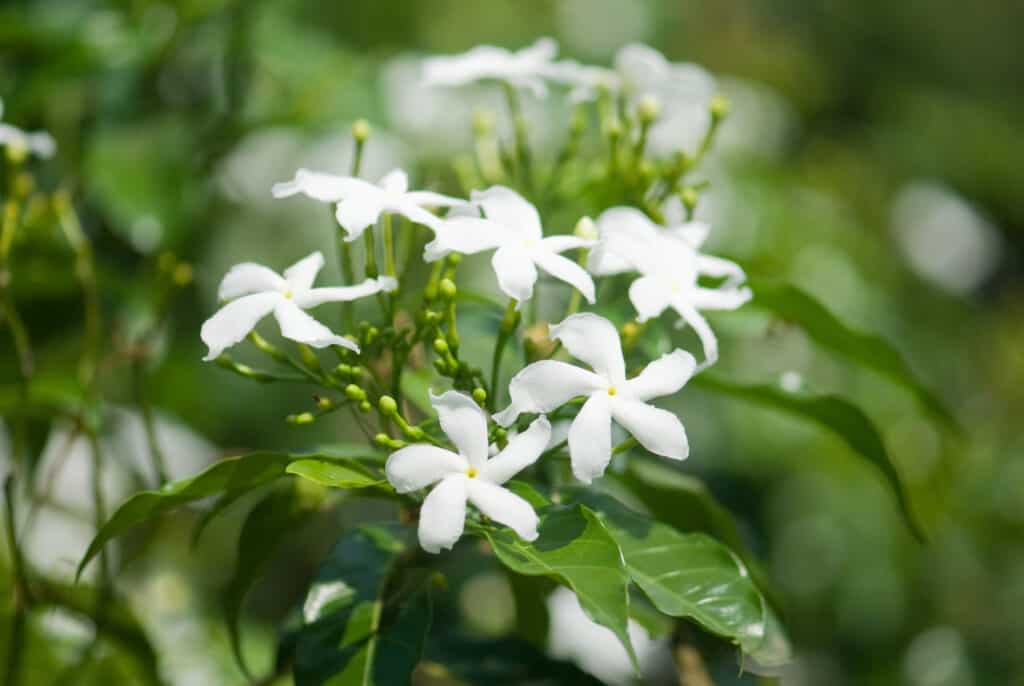
While there are many species of jasmine, the most prevalent is the common jasmine.
©Tukaram.Karve/Shutterstock.com
Scientific name: Jasminum
There are hundreds of different jasmine species but the most well-known is the common jasmine plant. This is the one you typically encounter in neighborhood gardens. The flowers are white and star-shaped, and the fragrance lingers like an aura around the vines — it’s sweet and fruity with an underlying musk that makes it wildly attractive to passersby. This plant grows tall (up to 15 feet) and blooms between the later days of summer through the early days of fall. Full-sun conditions are best for the star-shaped clusters to flourish, releasing their beauty and intoxicating scent.
2. Rose
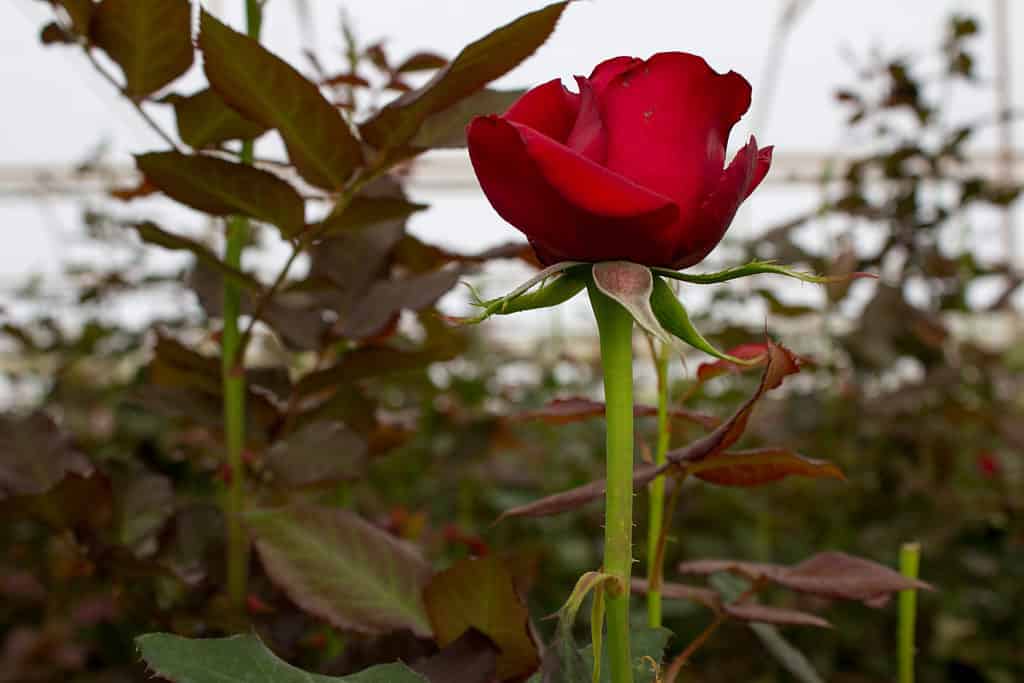
Red roses aren’t the only type of rose, but they are the most popular.
©nataliaec/Shutterstock.com
Scientific name: Rosa
A popular go-to for romantic gestures, roses have feather-like petals that embrace one another in a swirl design. They are held erect by long stems that counter their soft, flawless beauty with prickly thorns. The most revered roses include red, pink, and white but they also naturally grow in other colors like coral, yellow, and purple (though these are rare). The scent of roses differs depending on the type and the season. It’s always best to get up close and personal with roses to better determine their scent. Often, the scent is warm and aromatic, with light, fruity notes. They may also have a slight musk that grounds the scent, making it longer lasting.
3. Lavender
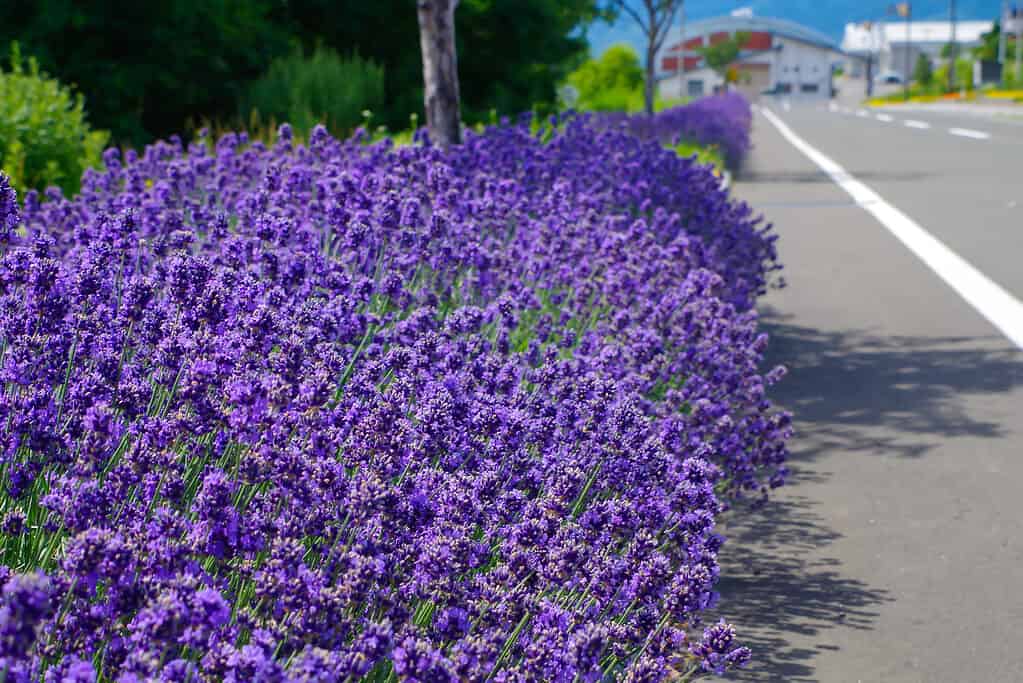
The most common lavender species all have purple flowers.
©ajisai13/Shutterstock.com
Scientific name: Lavandula
Lavender is easily recognized by its color. There are several different types like English lavender, French lavender, and Spanish lavender but they all have purple flowers. They need full sun to flourish and are a relatively low-maintenance plant. As the base gets woodier, pruning is required. This helps to stimulate the plant’s growth. The defining color is best appreciated during the summer months between July and August. Lavender has a soothing scent that can be described as powdery and herbal. It’s delicate with a lingering sweetness and a slight woody fragrance. Some varieties have a stronger, more penetrating scent that can be described as earthy, spicy, and cooling.
4. Stargazer Lily
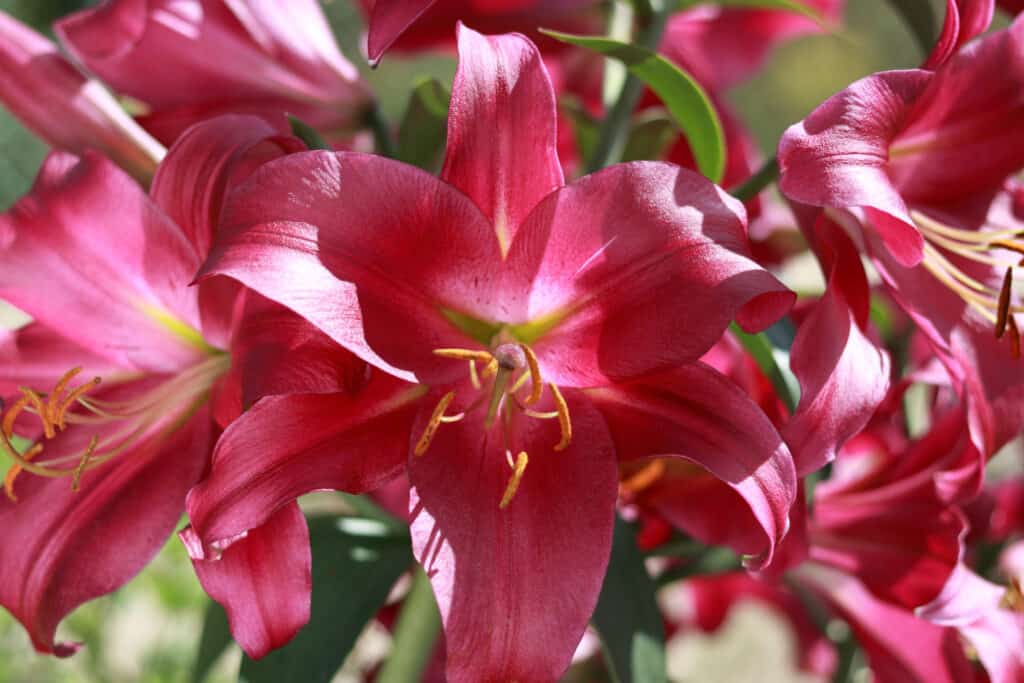
The sweet scent of the stargazer lily is particularly pungent.
©iStock.com/Mariia Romanyk
Scientific name: Lilium orientalis ‘Stargazer’
This hybrid lily grows rather quickly and is known for its beautifully complex appearance and strong perfume fragrance. The flowers are rich in crimson, pink, and white. The edges of the petals are like white lace surrounding the flower and as you investigate the center of the petal, the pink intensifies into a magenta color. Sprinkled, like freckles, throughout the petals is a crimson color, tying it all together in a satisfying visual display. Stargazer lilies have a sweet and pungent scent that may be too strong for some. It’s not subtle by any means, and lingers, even as a bouquet is moved to another room.
5. Primrose
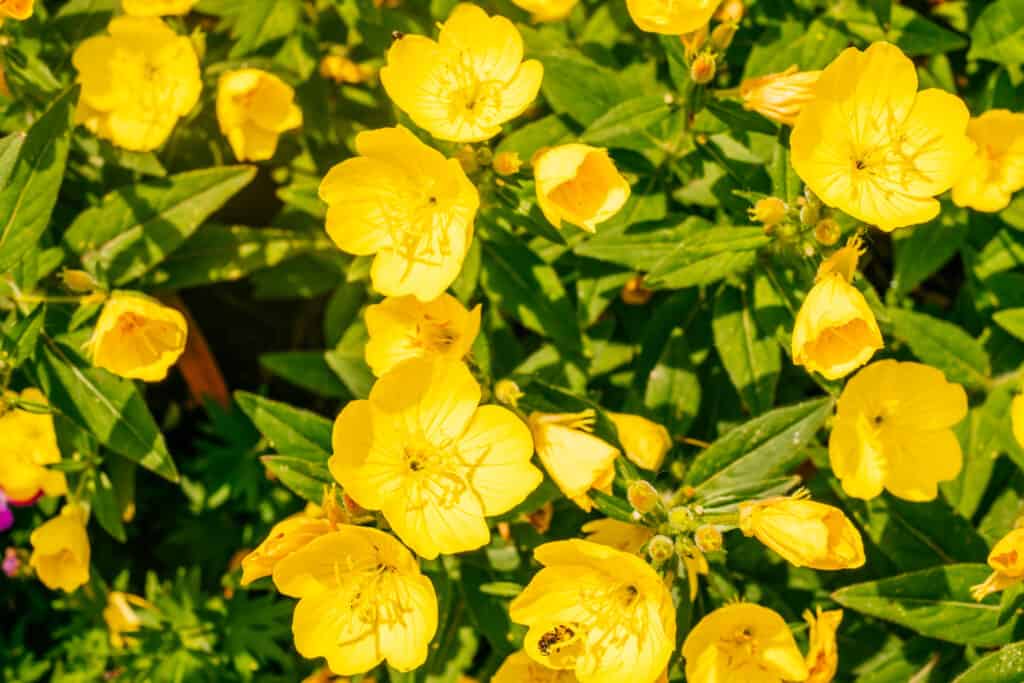
Primroses smell sweet and tangy, providing a citrus-y scent.
©iStock.com/Christina Vartanova
Scientific name: Primula vulgaris
With over 400 species of primrose, there’s plenty of variety to choose from. The species thrive in different environments and blossom uniquely, bursting with color in their tightly packed blooms. If spring had a scent, it would be that of primrose blooms. They smell sweet and tangy, like your favorite orange creamsicle. If you enjoy citrus-scented environments, primrose makes a great addition to a home or garden. The scent is sunny with a cool undertone that doesn’t overpower. It’s soft and dopamine-boosting.
6. Honeysuckle
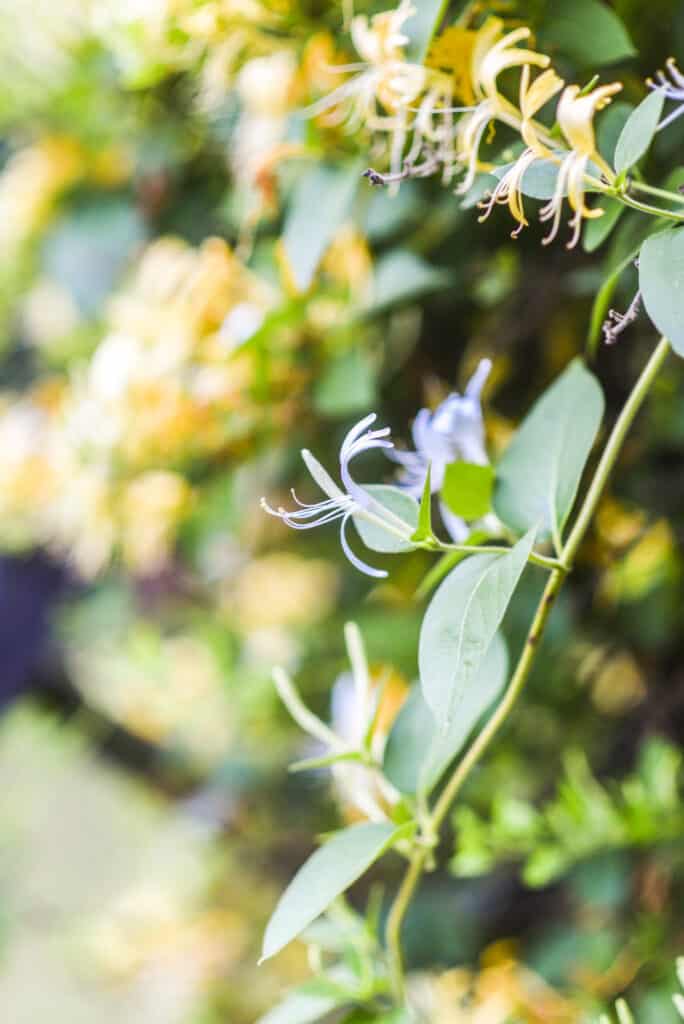
Not only do common honeysuckles smell good, but they also produce a sweet, honey-like nectar that is edible.
©iStock.com/Kamila Kozioł
Scientific name: Lonicera
There are approximately 180 species of honeysuckle found throughout the world. The flowers are attractive, making them a popular choice for gardens. They either grow as shrubs or as vines, which climb up onto any supporting structure, so long as it’s not flat. The shrubs have flowers that bloom white and change to a yellow color. They’re trumpet-shaped and may also have a slight pink flush as if the flower were blushing at your admiration. Honeysuckle has a scent reminiscent of jasmine, except if it were paired with vanilla spice. It’s nectarous and potent, stimulating your senses even from a distance.
7. Orange Blossom
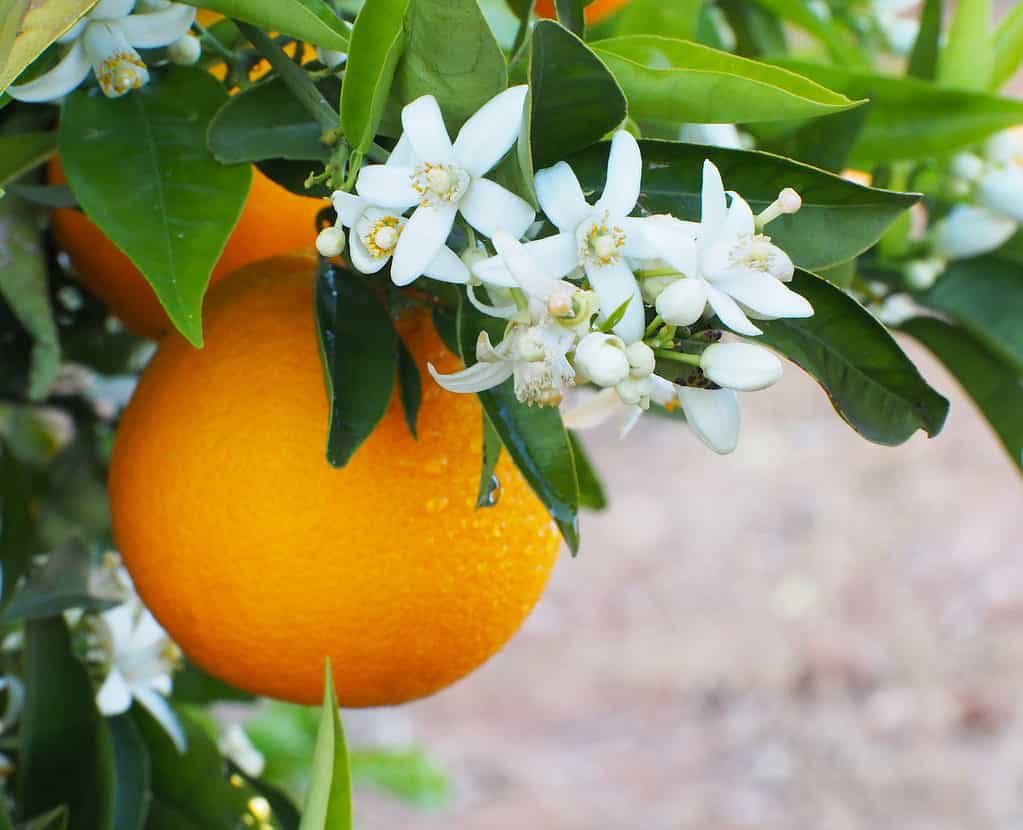
True to their name, orange blossoms grow on orange trees.
©Iness_la_luz/Shutterstock.com
Scientific name: Citrus sinensis
Orange blossoms keep true to their name — they grow on orange trees. When they first appear, they’re tiny round buds, white in color, and about the size of a pea. As they bloom, they change shape into a beautiful, five-petaled flower. They’re often seen in spring, but orange trees are evergreen, so you may spot them year-round alongside oranges. Orange blossom has a more complex scent than other flower varieties. Depending on the type, it may smell citrusy with notes of honey and bright flowers. However, it may also have a clean, soap-like scent infused with hints of baby powder.
8. Gardenia

Gardenias have a creamy, coconut-like scent.
©Lapha.R/Shutterstock.com
Scientific name: Gardenia jasminoides
Most of the time, gardenias are white with a little bit of yellow in the center of the flower. As gardenias age, their color may shift to more of a cream, yellowish color. These flowers are distinct from others in that their petals layer on top of one another, creating a gorgeous spiral display. They are different from the spiral appearance of roses, however. The outer petals open gracefully, displaying the many petal layers inside. Some gardenia species don’t have this complex appearance and instead feature single petal layers. The scent of gardenias is creamy, almost like coconut. They have a potent floral aroma that emanates from the flower with a bit of zest kicking it up into the air.
9. Magnolia
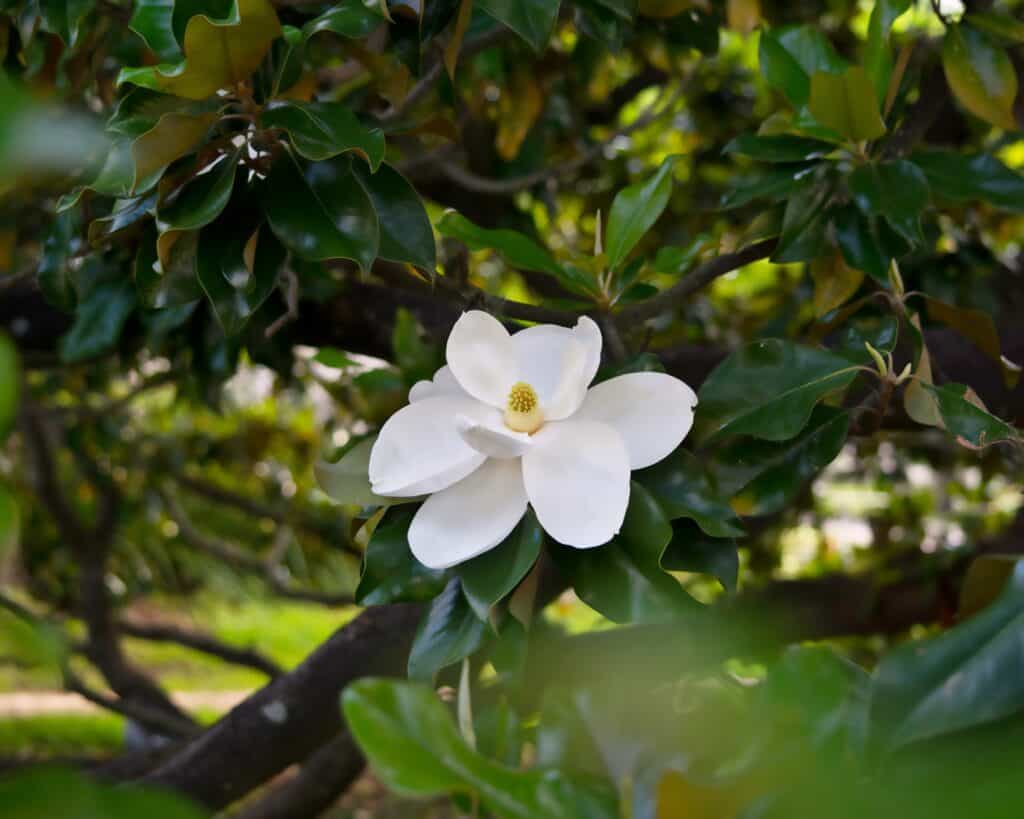
Magnolias are particularly large, with a floral scent of citrus and a hint of fruit.
©iStock.com/Dwbenjam
Scientific name: Magnolia
Consider magnolias statement pieces. These flowers are usually quite large, growing up to a foot across. Common magnolia colors include pink, white, red, purple, and yellow. They are similar in appearance to tulips when they have a bowl shape, but they may also be shaped like stars. They’re stunning and steal the show — these are definitely not going to sink into the background like a wallflower. In keeping with their elegant, standout vibe, magnolias smell like champagne. It’s a celebration of light, citrus scents combined with floral notes and just a hint of fruit, the way a single strawberry decorates a bubbling champagne glass.
10. Sweet Pea
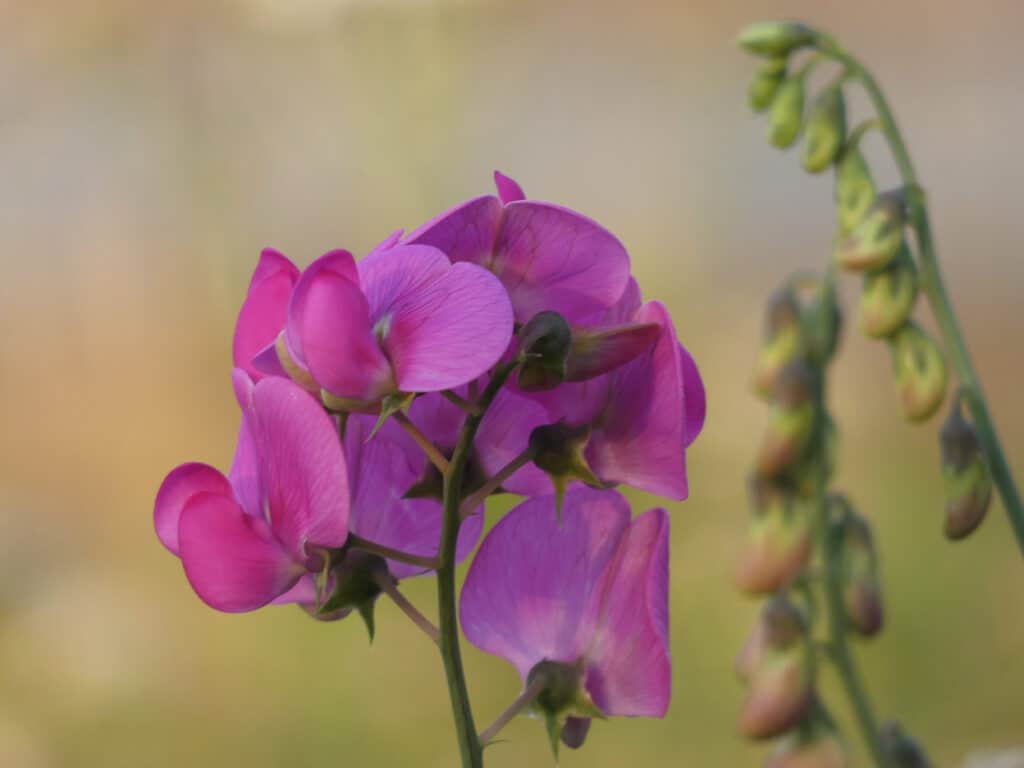
Sweet peas smell like jasmine and orange blossoms.
©Slawinka/Shutterstock.com
Scientific name: Lathyrus odoratus
Sweet peas are a feast for the eyes. They’re vines that climb and hang down like long, wavy fingers pointing delicately at their surroundings. Their colors are bright and sometimes blend together for an even more impressive display. You can find them in pink, violet, blue, rose, crimson, and apricot colors, to name a few. They smell like other flowers on this list, including jasmine and orange blossoms. Not surprisingly, the scent is sweet like honey with some even comparing it to that of fragrant grapes.
The Worst-Smelling Flowers
1. Titan Arum

Another name for the titan arum is corpse flower, because it smells like a rotting corpse.
©iStock.com/passion4nature
Scientific name: Amorphophallus titanium
Titan arum is a bit like magnolias in that they’re both statement pieces. It’s also similar to jasmine in that it grows tall. But that’s where the similarities end. Titan arum grows nearly 10 feet tall and has an inverted umbrella-like appearance. The spathe is a mix of green and cream on the outside and the inside is dark purple, almost crimson. The spadix emerges from the center, tall and proud, somewhat yellowish and brown. Just as loud as it is in appearance, titan arum has a scent that lingers like an unwanted guest. A guest that died. In your basement. The smell is compared to that of rotting flesh and though wildly unpleasant, it serves a purpose. It attracts pollinators, which ensures its continued survival.
2. Western Skunk Cabbage

The odor western skunk cabbage emits is very much skunk-like, attracting pollinators.
©Tom Meaker/Shutterstock.com
Scientific name: Lysichiton americanus
Western skunk cabbage is yellow and bright green. During the spring, it flowers from a single stalk, spreading around the spadix appearing almost like the skin of a lemon. At first glance, the spadix looks like a head of corn. The western skunk cabbage certainly has a well-identifying name. The aroma that emanates from it is skunk-like, sometimes reminiscent of rotting meat. Like the titan arum, this stink attracts pollinators. It also helps with keeping pests away, like raccoons and squirrels. Those who have edible gardens can make use of western skunk cabbage to protect their harvest.
3. Stinking Corpse Lily

While the titan arum is technically a larger cluster of flowers, the stinking corpse lily is the largest single flower in the world.
©Mazur Travel/Shutterstock.com
Scientific name: Rafflesia arnoldii
The stinking corpse lily grows to about three feet in diameter and emanates an unpleasantly pungent scent. It is reddish-brown with whitish-pink freckles throughout. This odorous plant also has five large petals and is similar to fungi. It shares similarities with titan arum and western skunk cabbage in that it stinks of rotting flesh (there is a theme here!). It remains discreet until the time of blooming and doesn’t have any roots, stems, or leaves. In the center, there are spikes and though they must surely serve a purpose, researchers are unclear about what that purpose is.
4. Stinking Root Parasite

Stinking root parasites grow underground as they cling to
Euphorbiaplants.
©Bihrmann/Shutterstock.com
Scientific name: Hydnora africana
The stinking root parasite also has an apt name. It’s native to South Africa and calls the earth its home. It grows underground while clinging to the roots of Euphorbia plants, which are tough and perennial. Inside the bright red stinking root parasite are little surprises in the form of black beetles, which are naturally attracted to its scent. The flower has small hairs that point downward and trap the black beetles; however, when it unfolds, it releases them. The odor that emanates from the stinking root parasite is not rotting flesh like you may have guessed. Rather, the stench is more like manure.
5. Carrion Flower
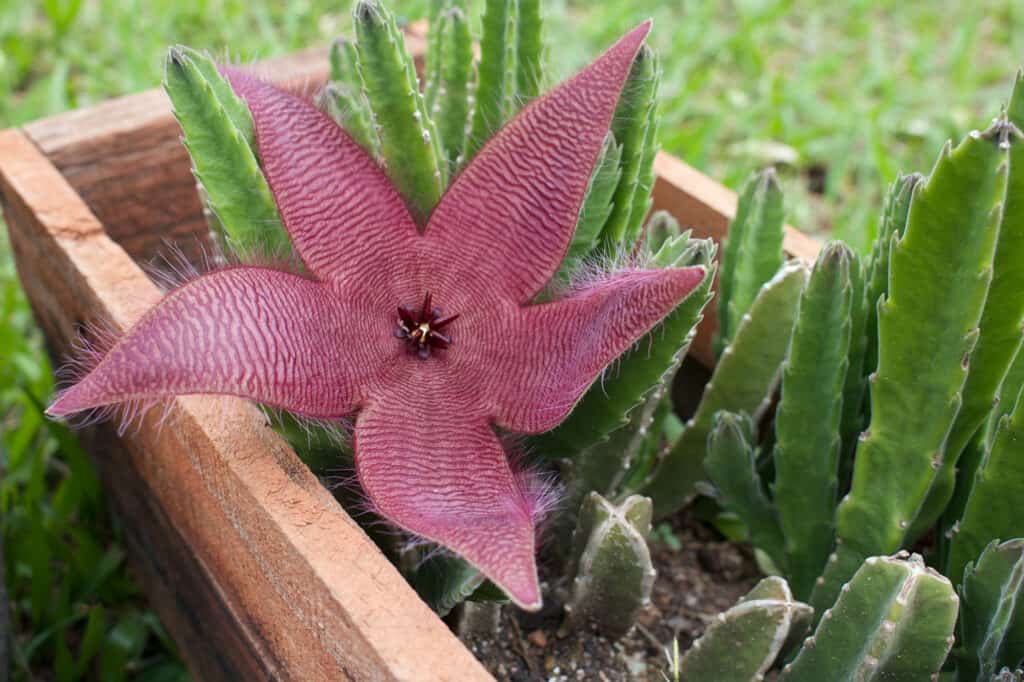
Carrion flowers emit an odor reminiscent of rotting flesh, attracting pollinators and serving as a nest for their eggs.
©Cristina Gurski/Shutterstock.com
Scientific name: Stapelia
The carrion flower brings us back to the smell of rotting flesh. It looks like a tired starfish that has reached the end of its rope. The star shape, when positioned correctly, mimics a head and limbs. The five petals hang down loosely, the way you would look if you fell back onto a couch, exhausted, your limbs lifelessly draping over it. Inside, the flower is a bit yellow, reddish, and purple and it’s hairy throughout. The odor attracts pollinators, and it serves as a nest for their eggs.
The photo featured at the top of this post is © guentermanaus/Shutterstock.com
Thank you for reading! Have some feedback for us? Contact the AZ Animals editorial team.






